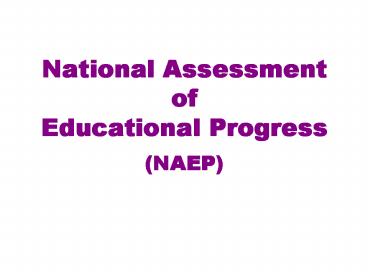National Assessment of Educational Progress NAEP - PowerPoint PPT Presentation
1 / 16
Title:
National Assessment of Educational Progress NAEP
Description:
Educators, members of local and state government, testing experts, business ... 5 mins. NAEP Test Development Steps. Five Year Cycle (e.g., science) ... – PowerPoint PPT presentation
Number of Views:90
Avg rating:3.0/5.0
Title: National Assessment of Educational Progress NAEP
1
National Assessment ofEducational
Progress(NAEP)
2
NAEP Organization
Congress (P.L. 107-279 NCLB)
National Assessment of Educational Progress
(NAEP) The Nations Report Card
Operations
Policy
NAEP
National Assessment Governing Board (NAGB)
National Center for Education
Statistics (NCES)
Implementation
Outside Contractors for - Framework
development - Achievement level setting - Test
development administration - Scoring,
analysis, reporting - Etc.
3
National Assessment Governing Board
- History
- Established by Congress in 1988
- Reauthorized in 1994 and 2002
- Composition
- 26 members
- Bipartisan broadly representative
- Educators, members of local and state government,
testing experts, business representatives,
general public - Statutory Responsibilities
- Select subjects to be assessed,
- Develop assessment frameworks and specifications
- Set student performance levels
- Develop guidelines for reporting NAEP results
- Design assessment methodology
- Approve all test items
- Improve the form and use of NAEP
- And other duties
4
NAEP Components
5
Characteristics of Main NAEP
- Large-scale, nationally-representative
assessment at grades 4, 8, 12 not a test for
individual students - State-level assessments in reading, mathematics,
science, and writing (grades 4 8) - Reading and math administered every two years at
the state-level in grades 4 and 8 - Science given every four years
- Trial urban district NAEP started in
2002 continued in 2003 and 2005
6
What NAEP Can Do Well
- NAEP commands national notice for its
- role in monitoring student achievement
- methodology, as a model for assessment
- focus on standards-based reporting
- NAEP frameworks are a resource for international,
state, local curriculum and assessment - NAEP can be used for research
7
NAEP Assessment Design
- Two Forms of Sampling
- Student Sampling National
samples about 10,000 15,000 students per
grade, per subject - State Samples - 2,500 per grade, per
subject - Item Sampling - matrix sampling design each
student takes only a small portion of the items
in a subject area (about 60 minutes of testing
time)
8
NAEP Assessment Design
- Type of Data Collected
- Cognitive Questions
- multiple choice
- short answer (short constructed response)
- extended constructed response
- performance tasks (in some subjects)
- Background Questions - Student, Teacher, School
- demographics
- school/instructional factors
- other factors related to achievement
- teacher preparation
- instructional methods
- school policies and practices
9
NAEP Student Booklet Design
- Block 1
- 25 minutes of cognitive items
- Block 2
- 25 minutes of cognitive items
- General background questions
- 5 mins.
- Subject specific background questions
- 5 mins.
10
NAEP Test Development Steps
- Five Year Cycle (e.g., science)
- Framework Development Process (2005) Assessment
framework (content) Specifications (detailed
blueprint) Preliminary achievement
level descriptions - Test development (2006 - 2007)
- Item reviews (content, bias, etc.) (2006 - 2007)
- Field testing more reviews (2007 - 2008)
- Operational testing (2009)
- Setting achievement levels (2009)
- Report preparation and review ( 2010)
- Release of NAEP results (2010)
11
Reporting NAEP Results
- Average Scale Scores
- Percentages of students attaining achievement
levels (basic, proficient, advanced) - Results for the nation and for subgroups of
students - Results for participating states and
jurisdictions (reading, math, writing, and
science grades 4 8) - Contextual information provided by
students, teachers (4th 8th), and school
administrators
12
NAEP Achievement Levels
- How are achievement results reported?
- BASIC partial mastery
- PROFICIENT solid academic performance
- ADVANCED superior performance
Achievement Level Policy Definitions Basic
Partial mastery of prerequisite knowledge and
skills that are fundamental for proficient
work at each grade. Proficient Solid
academic performance for each grade assessed.
Students reaching this level have demonstrated
competency over challenging subjects matter,
including subject- matter knowledge, application
of such knowledge to real-world situations, and
analytical skills appropriate to the subject
matter. Advanced Superior performance.
13
NAEP Science Achievement Levels
14
Science Achievement Level Description Grade 8
Proficient
- Students performing at the Proficient level
demonstrate much of the knowledge and many of the
reasoning abilities essential for understanding
of the Earth, physical, and life sciences at a
level appropriate to grade 8. For example,
students can interpret graphic information,
design simple investigations, and explain such
scientific concepts as energy transfer. Students
at this level also show an awareness of
environmental issues, especially those addressing
energy and pollution.
15
NAEP Frameworks
- Are developed through a comprehensive, inclusive,
and deliberative process - Describe the content and format of a NAEP
assessment - Are written for a general public audience
- Answer 3 major questions
- WHAT should be measured at grades 4, 8, and 12?
- HOW should NAEP be designed to measure
that set of content/skills? - HOW MUCH should students know and be able to do
at the basic, proficient, and advanced levels?
16
Web Sites
- NAGB www.nagb.org
- NAEP nces.ed.gov/nationsreportcard

